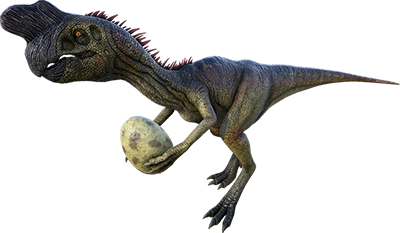 Dododex
ARK: Survival Evolved & Ascended Companion
Dododex
ARK: Survival Evolved & Ascended Companion
Tips & Strategies

Egg-stealing dinosaur was innocent,
THE rare discovery of a fossil embryo has cleared the name of a dinosaur
called “egg stealer”. Oviraptor, first discovered apparently making a meal of
another dinosaur’s eggs, was, it now turns out, simply trying to hatch its own
offspring.
In 1923, an expedition from the American Museum of Natural History in New
York found the first Oviraptor skeleton on a nest of eggs in the Mongolian
desert. The scientists thought the elongated eggs belonged to Protoceratops, a
plant-eating dinosaur whose fossils were common in the area. They chose the
name Oviraptor because they assumed the animal, a predator with sharp claws
and a parrot-like beak, was trying to eat the eggs when it was caught in a
sandstorm and died.
No one could confirm that a Protoceratops had definitely laid the eggs,
however. The contents of fossil eggs are hardly ever preserved. But in the
latest issue of the journal Science, a team of researchers from Mongolia and
the American Museum report on their discovery of a very similar egg containing
a tiny Oviraptor skeleton, almost ready to hatch. The egg was found 300
kilometres from the site of the 1923 excavations.
The 80-million-year-old embryo is the first found from the group of
dinosaurs related most closely to birds. Like birds, dinosaurs brooded their
young, says Mark Norell of the American Museum.
Advertisement
The same nest contained another curious find – the skulls of two tiny young
carnivores belonging to the same family as the velociraptors, best known as
the terrors of Jurassic Park. It is possible that these small carnivores were
raiding the nest. However, Norell says the absence of any other bones suggests
the skulls “were brought to the nest by adult [oviraptors] who had cleaned out
a Velociraptor nest” and like modern ospreys, brought their catch home to
eat
More Oviraptor Utility Tips
Everyone needs to know and it is dev confirmed that Oviraptors DO NOT buff chances of mutations or twins or triplets. This is a long going myth that needs to be shut down. Any twins or triplets you are getting is purely coincidence. This was said by one of the devs on twitter!
higher levels increase range. NOT melee
you do not need to increase weight, it will pick up all eggs in its range.
make sure it has food in the trough or it will eat eggs. and yes, it prefers the big eggs over the small when it gets hungry.
the egg buff does work. load with rocks and put on wander. works even better if using mated pair of oviraptors. but buff doesn’t stack.
These guys can steal eggs without aggroing surrounding dinos! You can get easy wyvern and rock drake eggs! Put it in a cryo pod, sneak into a nest, pop it out of the pod and have it set to follow close, run to the other side of the nest and when it gets to the nest it will take the egg. Once it has the egg you can take the egg from it and there won't be any aggro. Just make sure you don't switch the egg out of your inventory because you'll get the aggro then. Rinse and repeat for super easy wyvern and rock drake eggs!